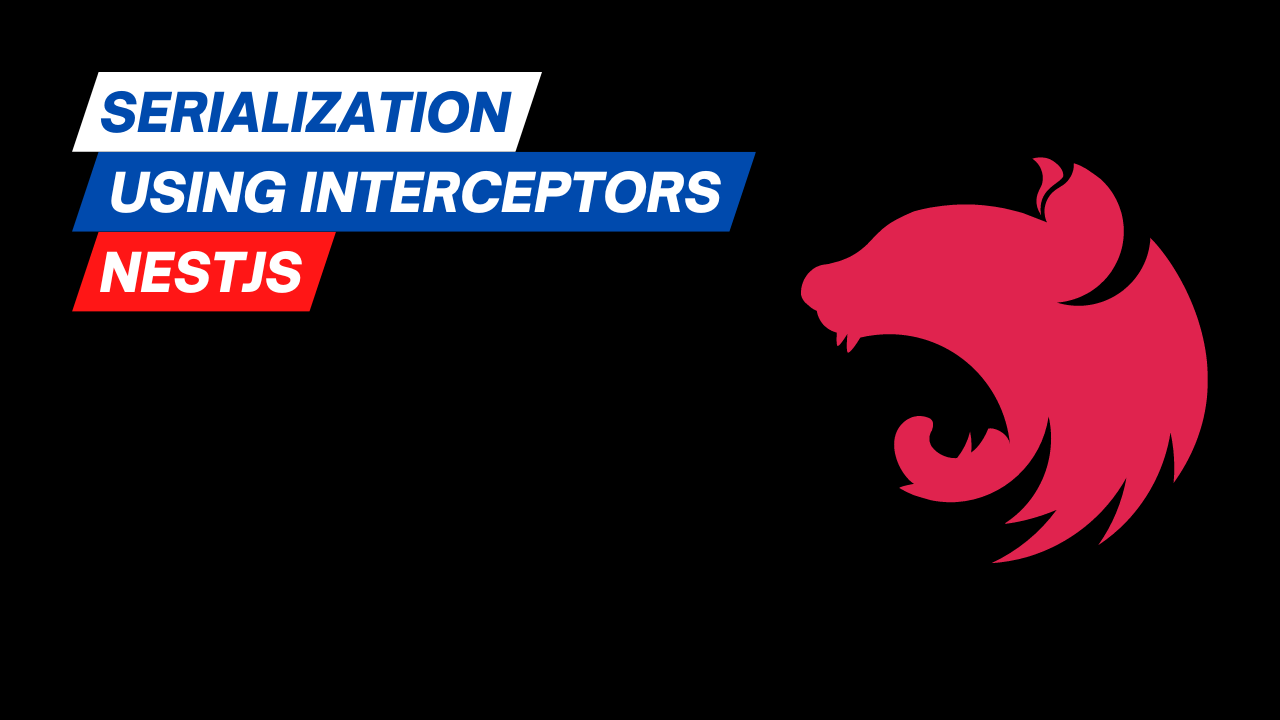Serialization
Excluding Response Properties (Serialization)
Sometimes we want to filter some properties in responses. For example, in the example shown below, it might not be desirable to expose password property of a user. In this case, we can exclude some properties in the reponse by intercepting incoming/outgoing request/response.
request.http
### find a user GET http://localhost:3000/auth/1
response
HTTP/1.1 200 OK X-Powered-By: Express Content-Type: application/json; charset=utf-8 Content-Length: 53 ETag: W/"35-heZRNA5dvWRMtp0xg4XRndTQjpg" Date: Mon, 09 May 2022 10:42:15 GMT Connection: close { "id": 1, "email": "[email protected]", "password": "test123" }
NestJS recommended approach
NestJS provides a way to exclude response properties.
Documentation | NestJS - A progressive Node.js framework
As mentioned in the NestJS documentation, we can use ClassSerializerInterceptor to apply rules expressed by class-transformer decorators on an entity/DTO class.

- setup some rules inside of the entity
- wire up interceptors to the controller
1. setup some rules inside of the entity
First, in the entity file, we annotate the entity we want to exclude from the response as follows:
In the user.entity.ts we will add @Exclude() decorator to the password property.
<aside> 📌 `**@Exclude()` decorator**import { Entity, Column, PrimaryGeneratedColumn } from "typeorm"; import { Exclude } from "class-transformer"; @Entity() export class User { @PrimaryGeneratedColumn() id: number; @Column() email: string; @Column() @Exclude() password: string; }
Sometimes you want to skip some properties during transformation. This can be done using @Exclude decorator:
Note that we included Exclude from class-transforer and used @Exclude() decorator to the target property.
2. wire up interceptors to the controller
To intercept and manipulate outgoing responses, we have to import UseInterceptors and ClassSerializerInterceptor from @nestjs/common.
And then we add the @UseInterecptors(ClassSerializerInterceptor) to findUser() controller. This will make the app apply rules expressed by class-transformer decorators on an entity class.
users.controller.ts
... @UseInterceptors(ClassSerializerInterceptor) @Get('/:id') findUser(@Param('id') id: string) { return this.usersService.findOne(+id); } ...
The password is no longer included in the response object.
request.http
### find a user GET http://localhost:3000/auth/1
response
HTTP/1.1 200 OK X-Powered-By: Express Content-Type: application/json; charset=utf-8 Content-Length: 31 ETag: W/"1f-zIMGjcodIc4aqvig7x0gEfkI6WM" Date: Wed, 15 Jun 2022 22:34:03 GMT Connection: close { "id": 1, "email": "[email protected]" }
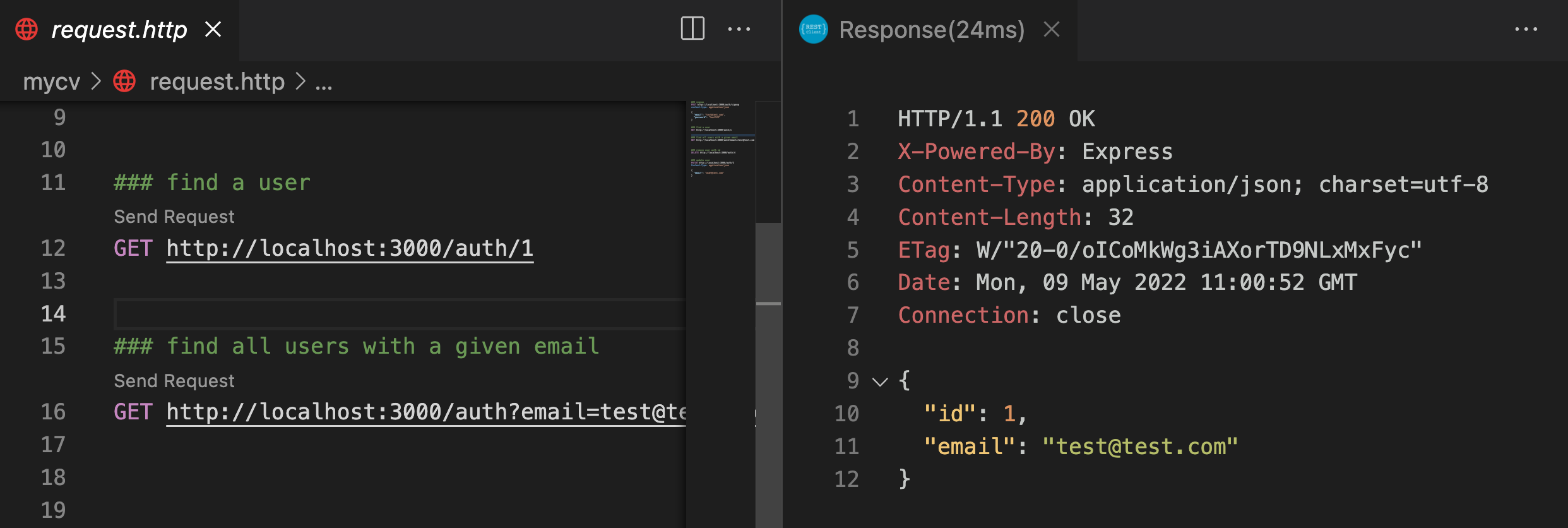
Downside of the ‘NestJS recommended approach'
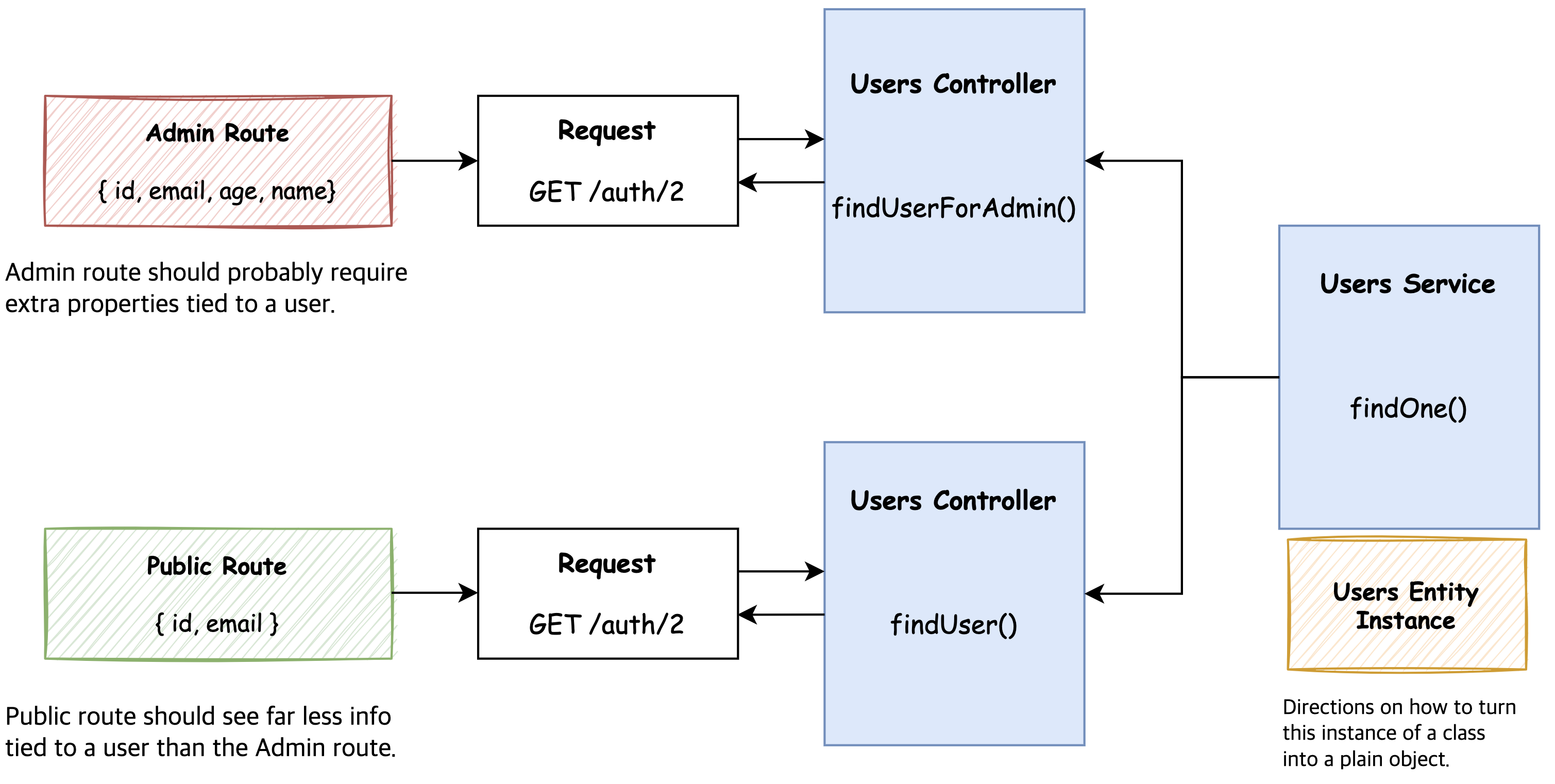
There is an issue with using ClassSerializerInterceptor as mentioned in the NestJS document. Think about the following situation. User’s service returns informations tied to a user. Through admin route, we might want to get extra properties tied to a user. And the public route should expose only non-sensitive information. If we use the way introduced in the NestJS document to serialize response, there is no way to serve different data for admin routes and public routes through one method that returns user information.
Another approach
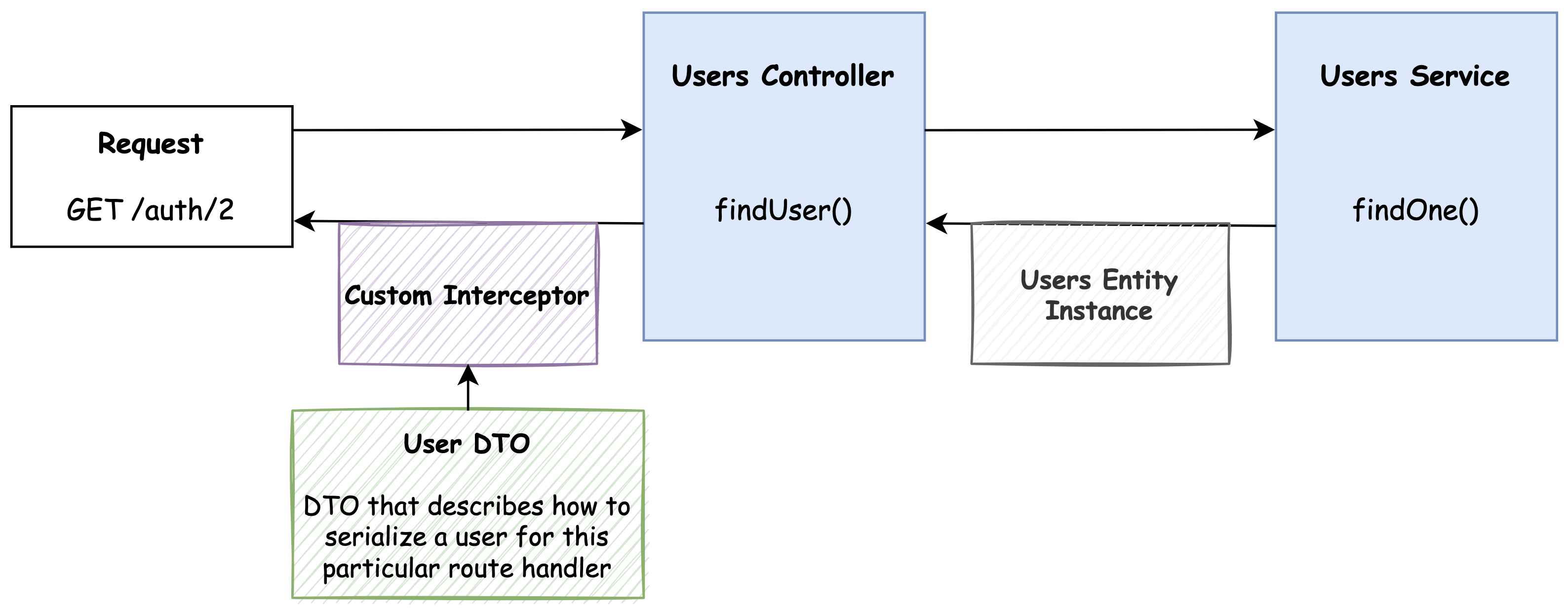
We are no longer tie formatting information directrly to the entity instance since it hinders using the entity intsance in multiple route handlers with different purposes.
Instead, we can define custom interceptor. Inside the custom interceptor, we’re going to serialize the entity instance to an plain object by using serialization rules set up inside the DTO. This can describe how we want to format an entity (what properties we want to include) for a very particular route handler.
How to build interceptors
Interceptors can intercept incoming / outgoing responses.
Interceptors can be applied to a single handler, all the handlers in a controller, or globally.

The basic structur of the interceptor is as follows.
class CustomInterceptor { intercept(context: ExecutionContext, next: CallHandler) {} }
- intercept : intercept method is called automatically whenever the interceptor need to run
- context: Information on the incoming request
- next: kind of a reference to the request handler in the controller
src/interceptors/serialize.interceptor.ts
import { UseInterceptors, NestInterceptor, ExecutionContext, CallHandler } from "@nestjs/common"; import { Observable } from "rxjs"; import { map } from "rxjs/operators"; import { plainToClass } from "class-transformer"; export class SerializeInterceptor implements NestInterceptor { intercept(context: ExecutionContext, next: CallHandler): Observable<any> { // Run something before a request is handled by the request handler. console.log(`Running before the handler`, context); return next.handle().pipe( map((data: any) => { // Run something before the response is sent out. console.log(`Running before the response is sent out`, data); }) ); } }
Using custom interceptor in the controller
users.controller.ts
import { Body, Controller, Delete, Get, Param, Patch, Post, Query, UseInterceptors, ClassSerializerInterceptor, } from '@nestjs/common'; import { CreateUserDto } from 'src/users/dtos/create-user.dto'; import { UsersService } from './users.service'; import { UpdateUserDto } from './dtos/update-user.dto'; import { SerializeInterceptor } from 'src/interceptors/serialize.interceptor'; @Controller('auth') export class UsersController { constructor(private usersService: UsersService) {} ... @UseInterceptors(SerializeInterceptor) @Get('/:id') findUser(@Param('id') id: string) { return this.usersService.findOne(+id); } ... }
We can see that the interceptor did activated as shwon below. The first log was printed before the request is handled by the request handler.
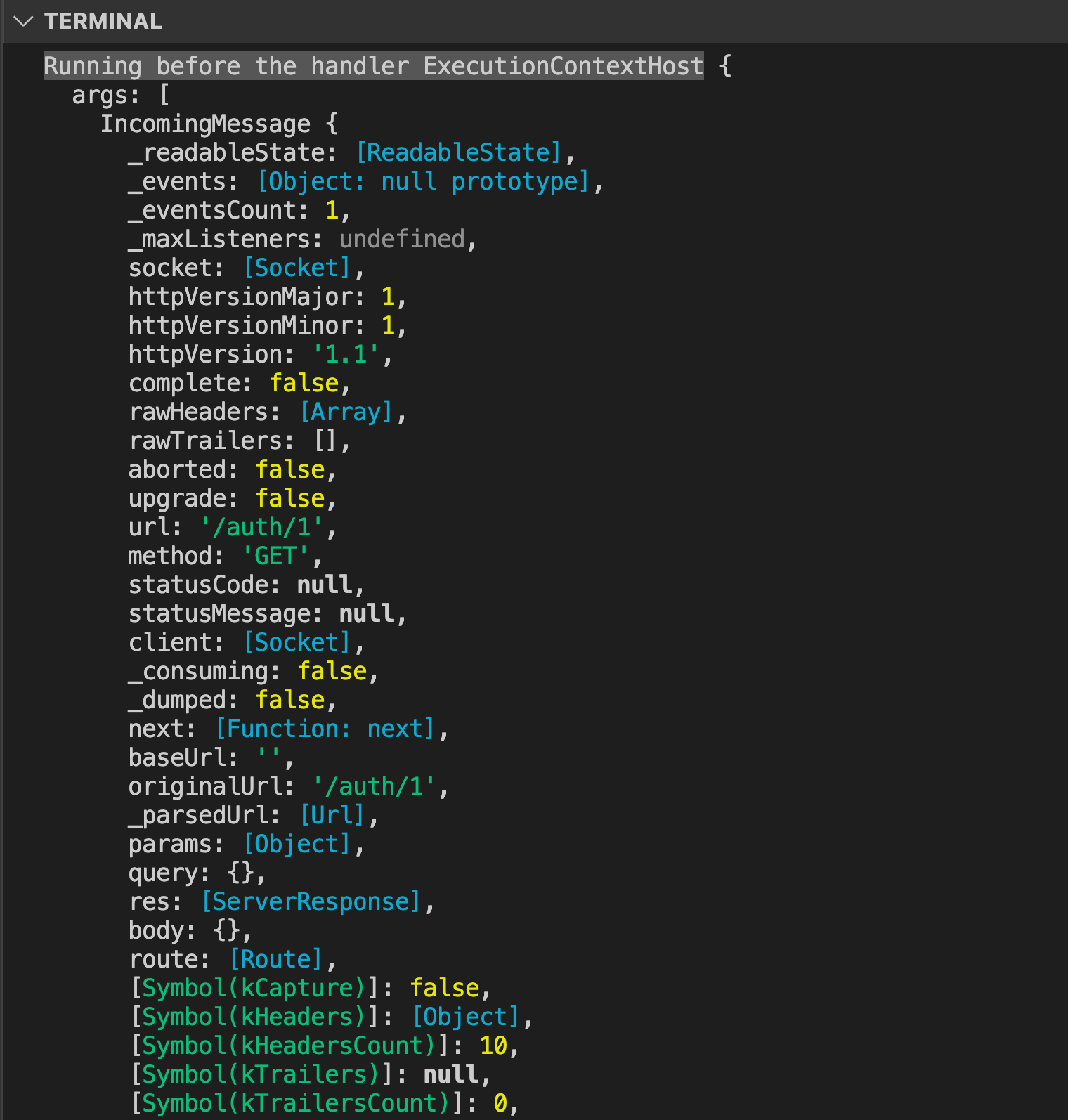
The second log was printed right before theresponse is sent out.

Adding serialization logic
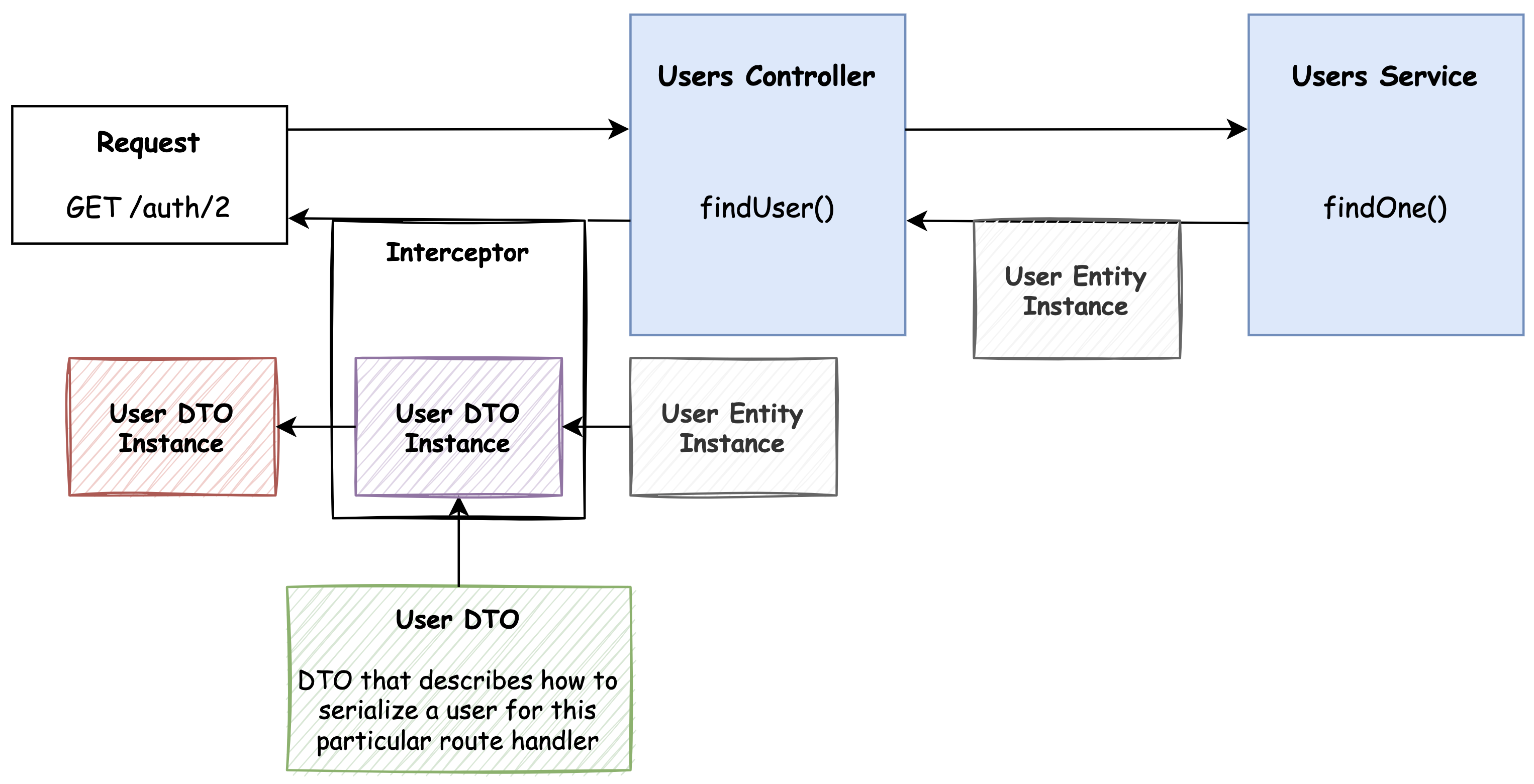
Normally, whenever we finish all of our request handlers, Nest is going to take whatever comes out of all this stuff and turn it into JSON for us. So usually the user entity instance will be turned into JSON, but we're going to hijack that process.
We're going to put in an extra step inside the process. We are going to take the user entity instance to convert it into a User DTO instance. This User DTO instanced is going to have all of different serialization rules. It's going to have the rules such as showing the ID and the email, but not the password and so on.
We are then going to directly return that instance, then Nest is going to take that instance and turn it into JSON automatically and finally send that back in the response.
creating UserDTO
src/users/dots/user.dto.ts
import { Expose } from "class-transformer"; export class UserDto { @Expose() id: number; @Expose() email: string; }
Importing UserDto into the interceptor
interceptors/serialize.interceptor.dto
import { UseInterceptors, NestInterceptor, ExecutionContext, CallHandler } from "@nestjs/common"; import { Observable } from "rxjs"; import { map } from "rxjs/operators"; import { plainToClass } from "class-transformer"; import { UserDto } from "../users/dtos/user.dto"; export class SerializeInterceptor implements NestInterceptor { intercept(context: ExecutionContext, next: CallHandler): Observable<any> { return next.handle().pipe( map((data: any) => { // Run something before the response is sent out. return plainToClass(UserDto, data, { excludeExtraneousValues: true, }); }) ); } }
- plainToClass This method transforms a plain javascript object to instance of specific class.
- excludeExtraneousValues: true
This option ensures that whenever we have an instance of user and try to turn it into plain JSON, it is only going to expose the properties that are specifically marked with that
@expose()directive. So if there are any other properties, they're going to be removed.
Testing
request.http
### find a user GET http://localhost:3000/auth/1
response
HTTP/1.1 200 OK X-Powered-By: Express Content-Type: application/json; charset=utf-8 Content-Length: 32 ETag: W/"20-0/oICoMkWg3iAXorTD9NLxMxFyc" Date: Tue, 10 May 2022 05:54:16 GMT Connection: close { "id": 1, "email": "[email protected]" }
As we described in user.dto.ts, only id and email properties (without including password) were returned.
Customizing the Interceptor’s DTO
Currently, interceptors/serialize.interceptor.dto only serialized UserDto . The Dto Class is hard coded in the interceptor’s code. To enhence re-usability of this interceptor, we can refactor it. This will enable us to use this interceptor to serialize response with otehr Dtos.
import { CallHandler, ExecutionContext, NestInterceptor } from "@nestjs/common"; import { plainToClass } from "class-transformer"; import { map, Observable } from "rxjs"; export class SerializeInterceptor implements NestInterceptor { constructor(private dto: any) {} intercept( context: ExecutionContext, next: CallHandler<any> ): Observable<any> | Promise<Observable<any>> { return next.handle().pipe( map((data: any) => { return plainToClass(this.dto, data, { excludeExtraneousValues: true, }); }) ); } }
The SerializeInterceptor class will receive dto as a parameter and plainToClass method will use this dto to serialize response properties.
To apply the interceptor, we can pass the desired DTO as a paremeter of the SerializeInterceptor class.
users.controller.ts
import { UserDto } from './dtos/user.dto'; @Controller('auth') export class UsersController { ... @UseInterceptors(new SerializeInterceptor(UserDto)) @Get('/:id') findUser(@Param('id') id: string) { return this.usersService.findOne(+id); } ... }
Testing
request
### find a user GET http://localhost:3000/auth/1
response
HTTP/1.1 200 OK X-Powered-By: Express Content-Type: application/json; charset=utf-8 Content-Length: 32 ETag: W/"20-0/oICoMkWg3iAXorTD9NLxMxFyc" Date: Tue, 10 May 2022 06:07:03 GMT Connection: close { "id": 1, "email": "[email protected]" }
Wrapping the Interceptor in a Decorator
For now, it requires a really long line of code and we have to import many classes to make use of the interceptor.
import { UserDto } from './dtos/user.dto'; import { SerializeInterceptor } from 'src/interceptors/serialize.interceptor'; import { UseInterceptors } from '@nestjs/common'; ... @UseInterceptors(new SerializeInterceptor(UserDto))
Let’s refactor this to make our code lean! To this end, we are going to make our own custom decorator.
Defining custom decorator
serialize.interceptors.ts
import { UseInterceptors, NestInterceptor, ExecutionContext, CallHandler } from "@nestjs/common"; import { Observable } from "rxjs"; import { map } from "rxjs/operators"; import { plainToClass } from "class-transformer"; export function Serialize(dto: any) { return UseInterceptors(new SerializeInterceptor(dto)); } export class SerializeInterceptor implements NestInterceptor { constructor(private dto: any) {} intercept(context: ExecutionContext, next: CallHandler): Observable<any> { return next.handle().pipe( map((data: any) => { // Run something before the response is sent out. return plainToClass(this.dto, data, { excludeExtraneousValues: true, }); }) ); } }
users.controller.ts
... import { Serialize } from 'src/interceptors/serialize.interceptor'; import { UserDto } from './dtos/user.dto'; @Controller('auth') export class UsersController { constructor(private usersService: UsersService) {} // @UseInterceptors(new SerializeInterceptor(UserDto)) @Serialize(UserDto) @Get('/:id') findUser(@Param('id') id: string) { return this.usersService.findOne(+id); } ... }
Rather than importing and using the very long line of code, we can symply use our custom decorator @Serialize() .
before refactoring
import { UseInterceptors, ClassSerializerInterceptor } from '@nestjs/common' import { SerializeInterceptor } from 'src/interceptors/serialize.interceptor'; @UseInterceptors(new SerializeInterceptor(UserDto)
after refactoring
import { Serialize } from 'src/interceptors/serialize.interceptor'; @Serialize(UserDto)
Type Safety around Serialize
For now, we useed any type definition for dto
constructor(private dto: any) {}
Let’s refactor this so that we can assure that this dto is at least a class.
serialize.interceptor.ts
interface ClassConstructor { // eslint-disable-next-line @typescript-eslint/ban-types new (...args: any[]): {}; }
This interface means that as long as it is a class type it is okay.
Now, we can apply this type definition to the type of dto.
serialize.interceptor.ts
import { UseInterceptors, NestInterceptor, ExecutionContext, CallHandler } from "@nestjs/common"; import { Observable } from "rxjs"; import { map } from "rxjs/operators"; import { plainToClass } from "class-transformer"; interface ClassConstructor { // eslint-disable-next-line @typescript-eslint/ban-types new (...args: any[]): {}; } export function Serialize(dto: ClassConstructor) { return UseInterceptors(new SerializeInterceptor(dto)); } export class SerializeInterceptor implements NestInterceptor { constructor(private dto: any) {} intercept(context: ExecutionContext, next: CallHandler): Observable<any> { return next.handle().pipe( map((data: any) => { // Run something before the response is sent out. return plainToClass(this.dto, data, { excludeExtraneousValues: true, }); }) ); } }
Now we can be sure that the dto will be a Class type. In the example shown below, we can see taht type string or number throws an error because it is not a Class type.



